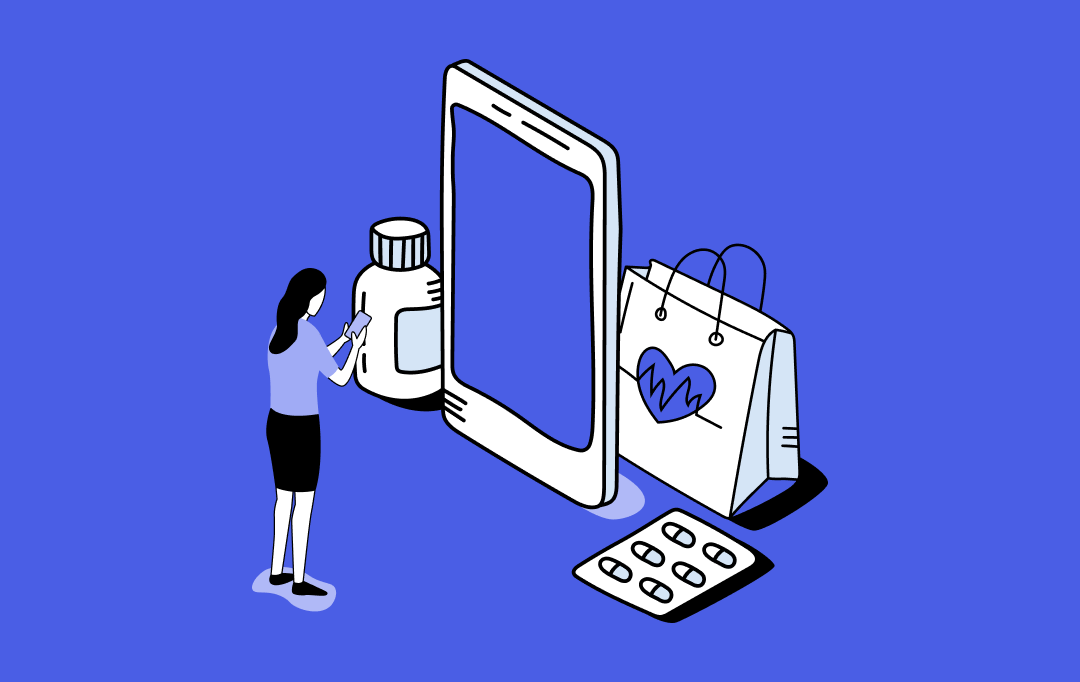- Types of Healthcare Ecommerce Platforms
- Online Pharmacies
- Medical Supplies and Equipment Stores
- Telemedicine Websites
- Healthcare Marketplaces
- Wellness and Fitness Ecommerce
- Health Insurance Marketplaces
- Specialized Ecommerce Platforms
- Healthcare Ecommerce Benefits
- Wider Accessibility
- Time Efficiency
- Cost Savings
- Enhanced Transparency
- Improved Patient Engagement
- Scalability for Providers
- Features of Healthcare Ecommerce Platforms
- Advanced Search and Filter Options
- Prescription Management System
- Telehealth Integration
- Real-Time Inventory Updates
- Secure and Flexible Payment Systems
- Product Comparison Tools
- Interactive Chatbots
- Multilingual and Multiregional Support
- Data Analytics Dashboard
- Multi-Layered Security Protocols
- Healthcare eCommerce Challenges
- Considering Factors To Build Healthcare Ecommerce App
- Defining Your Niche and Audience
- Building a Scalable Tech Infrastructure
- Emphasizing User Experience
- Prioritizing Regulatory Compliance
- Strengthening Partnerships
- Robust Supply Chain Management
- Leveraging Advanced Analytics
- Security and Data Privacy
- Diversifying Payment Options
- Enabling Omnichannel Support
- Top Ecommerce Trends in Healthcare
- AI-Driven Personalization
- Subscription-Based Models
- Integration of Wearables and IoT
- Voice and Visual Search
- Blockchain for Enhanced Transparency
- AR and VR Integration
- Focus on Sustainable Practices
- Growth of B2B Ecommerce
- Localized Services and Hyper-Personalization
- Appinventiv: Hub to Develop Your Bespoke Healthcare E-commerce Platform
- FAQs
Imagine this: a working mother notices her child has a persistent cough. Instead of rearranging her schedule to visit a clinic, she books a teleconsultation with a pediatrician, gets a prescription instantly, and orders the medicine online – all within an hour. Meanwhile, a rural patient needing advanced medical equipment can browse through an ecommerce platform, compare prices, read reviews, and have the device delivered to their doorstep.
This hyperconnected medical world can be brought alive through the power of ecommerce in healthcare – a rapidly evolving sector that has brought unprecedented convenience and accessibility to patients, caregivers, and providers alike.
At its core, healthcare ecommerce is a part of healthcare trends that bridge the gap between technology and healthcare, transforming how patients perceive healthcare services, including interaction, medication management, etc.

Over the past decade, the demand for ecommerce solutions for healthcare industry has surged, fueled by advancements in digital technology, shifting consumer expectations, and the global push toward telemedicine trends, especially post-pandemic.
But what exactly makes healthcare ecommerce? And how can businesses, innovators, and patients benefit from this transformative trend?
We are going to answer all of this today.
While the essence of ecommerce in healthcare is fairly straightforward, with it bringing healthcare products buying to a digital space, a lot goes into making the domain. Let us look into the details, starting with the healthcare eCommerce types.
Types of Healthcare Ecommerce Platforms
Healthcare eCommerce types encompass a variety of platforms, each tailored to meet specific needs across the industry. Below is a detailed exploration of the most prominent categories:

Online Pharmacies
These platforms allow customers to order both prescription and over-the-counter medications. Some, like PillPack (Amazon Pharmacy), specialize in organizing and delivering prescriptions in pre-sorted packs for daily use. The convenience of doorstep delivery, auto-refills, and competitive pricing have made online pharmacies indispensable, especially for patients with chronic conditions.
Medical Supplies and Equipment Stores
These platforms cater to diverse needs, from hospital-grade equipment to medication management apps to at-home medical devices like blood pressure monitors or CPAP machines. They often include B2C platforms for individuals and B2B solutions for hospitals and clinics requiring bulk purchases.
Telemedicine Websites
These platforms integrate ecommerce with healthcare consultations. After a virtual consultation, patients can directly order medications or diagnostic tests. To aid this, telehealth giants like Teladoc Health combine real-time video consultations with online prescription fulfillment, making healthcare more seamless.
Healthcare Marketplaces
Aggregators like Practo and Healthgrades are centralized platforms connecting patients with providers, labs, and pharmacies. These marketplaces offer a one-stop solution for booking appointments, accessing health services, and purchasing related products.
Wellness and Fitness Ecommerce
This growing healthcare eCommerce integration niche includes platforms selling dietary supplements, fitness equipment, mental health apps, and wellness products. For example, HL7 integration in healthcare is crucial for businesses aiming to enhance their patient care and operations. What is driving demand for holistic health solutions is the fact that consumers are increasingly prioritizing preventive healthcare through a more natural wellness route.
Health Insurance Marketplaces
Websites like HealthCare.gov in the US allow users to compare and purchase health insurance plans. For this, healthcare businesses even deploy health insurance development services and platforms to simplify complex insurance options, offering transparency and accessibility.
Specialized Ecommerce Platforms
Senior Care: Products for aging populations, like mobility aids or elder-friendly devices.
Pet Healthcare Ecommerce: Platforms focusing on veterinary practice management and supplies and medications for pets.
Rehabilitation Products: Ecommerce sites offering post-surgery or physiotherapy aids.
Healthcare eCommerce integration is shaping up by giving the medical industry a range of use cases that benefit not just healthcare providers but also patients and people on their fitness journey.
Let us explore the advantages of healthcare eCommerce, which makes the domain a valuable, profitable industry.
Healthcare Ecommerce Benefits
The advantages of healthcare ecommerce extend beyond convenience and its omnichannel nature. Let’s explore its transformative impact:
Wider Accessibility
Through healthcare ecommerce platforms, patients in remote or underserved areas gain access to medical supplies and consultations without the need for travel. This democratizes healthcare, reducing geographic and economic barriers.
Time Efficiency
Booking a doctor’s appointment, getting prescriptions, and ordering supplies can now be done in minutes as a key offering of healthcare ecommerce benefits. This can be as critical as a life-saver for busy professionals and caregivers.
Cost Savings
Online platforms often provide competitive pricing due to reduced overhead costs. Discounts, subscription plans, and bulk purchase options further lower expenses for patients and providers.
Enhanced Transparency
Reviews, ratings, and detailed product descriptions empower users to make informed decisions. Patients can compare prices, read expert opinions, and avoid counterfeit products.
Improved Patient Engagement
Another one of the healthcare ecommerce benefits lies in how digital health platforms can foster better communication and monitoring between doctors and patients. Ecommerce sites often integrate tools for tracking medication adherence and health outcomes.
Also Read: An Entrepreneur’s Guide to Patient Engagement Software
Scalability for Providers
For healthcare businesses, ecommerce offers a scalable solution for reaching larger audiences without investing heavily in physical infrastructure.
While these are only surface-layered healthcare ecommerce benefits, irrespective of how much you deep dive into the advantages, you will find the powerhouse of these pros lying at the epicenter of the features set used to build the healthcare ecommerce platform.
Features of Healthcare Ecommerce Platforms
Robust, scalable ecommerce solutions for healthcare industry typically stand out by integrating features that cater to consumer needs, operational efficiency, and healthcare compliance. Here is an in-depth look at the essential features.

Advanced Search and Filter Options
Users should easily find products or services using filters like price range, condition-specific categories, or brand preferences. Businesses can also consider adding AI-driven search enhancements to streamline navigation.
Prescription Management System
Healthcare ecommerce features for uploading, verifying, and managing prescriptions would ensure authenticity and convenience. Additionally, a functionality for automated reminders for prescription refills can add value to the user experience.
Telehealth Integration
Direct integration with telehealth services can enable users to consult healthcare professionals and order prescribed products on the same platform.
Real-Time Inventory Updates
Ensuring users have visibility into stock levels prevents order cancellations and enhances trust. Moreover, adding inventory alerts for critical products in the healthcare eCommerce feature set can improve patient satisfaction.
Secure and Flexible Payment Systems
Options like EMIs, PayPal, and digital wallets make payments convenient for users. Now, Irrespective of which medical digital payment mode you choose, your healthcare ecommerce platform should Incorporate PCI DSS-compliant systems to process payments securely
Product Comparison Tools
Healthcare ecommerce platforms should allow users to compare multiple products based on features, reviews, and pricing, empowering them to make informed decisions.
Interactive Chatbots
AI-powered chatbots can be explored to provide instant answers to user queries, recommend products, and guide navigation, all through the power of NLP in healthcare and AI-powered agents.
Multilingual and Multiregional Support
With healthcare being a globally connected phenomenon, supporting multiple languages and currencies would ensure inclusivity in the platform.
Data Analytics Dashboard
Robust data analytics in healthcare can provide insights into user behavior, product trends, and operational performance, enabling businesses to adapt quickly.
Multi-Layered Security Protocols
Features like multi-factor authentication systems in a mobile app, end-to-end encryption, and real-time fraud detection can protect sensitive healthcare data and ensure complete cybersecurity.
To fully realize the potential of healthcare ecommerce benefits, including features that enhance user experience, ensure compliance, and build trust, is essential. However, even the most advanced ecommerce in healthcare platforms can face unique challenges that must be addressed to deliver seamless and secure healthcare services.
Let’s explore the key challenges in healthcare ecommerce and how we overcame them.
Healthcare eCommerce Challenges
While healthcare ecommerce offers immense potential, it is not without challenges. Our extensive experience in healthcare and ecommerce app development services has built over 03 healthcare-centric ecommerce projects, which didn’t come without roadblocks.
Here are some of the issues we planned for and the solutions we found.
Maintaining Data Privacy and Security
With sensitive patient data at stake, healthcare platforms are prime cyberattack targets.
Solution: Implemented HIPAA-compliant platforms, blockchain technology, and rigorous security protocols. Moreover, invested in regular penetration testing to identify vulnerabilities.
Navigating Regulatory Complexities
Healthcare regulations differ across regions, making compliance a significant hurdle.
Solution: Employed a legal team to ensure global and local compliance and used AI tools to monitor regulatory updates.
Also Read: The Impact of AI in Healthcare Industry
Counterfeit Products
The sale of counterfeit or substandard products is a persistent issue.
Solution: Suggested that clients partner only with certified suppliers and implement product verification systems using QR codes or blockchain.
Logistics Challenges
Delivering fragile or temperature-sensitive items like vaccines poses logistical difficulties.
Solution: Used specialized cold-chain logistics providers and IoT-based monitoring for real-time condition tracking.
Gaining Consumer Trust
Convincing consumers to switch from traditional retail to online platforms can be challenging.
Solution: Highlighted certifications offer transparent return policies and display verified customer reviews prominently in the user interface.
While quite adverse, these challenges can be addressed by partnering with the right team of skilled developers. A team like us works with businesses as pseudo-CTOs – a partnership that goes beyond project delivery.
By tackling these challenges in healthcare ecommerce strategically, we help you lay the groundwork for a robust healthcare ecommerce platform. But success isn’t just about overcoming obstacles – it’s also about making informed decisions. Here are the key factors we suggest our partners consider when building a platform that stands out in this competitive landscape.
Considering Factors To Build Healthcare Ecommerce App
Creating an ecommerce in healthcare platform involves strategic planning and attention to several critical aspects. These factors ensure the platform’s sustainability, scalability, and user-centricity.

Defining Your Niche and Audience
Healthcare is a vast field, and attempting to cater to all audiences may dilute your value proposition. We suggest focusing on a specific niche, such as telemedicine for chronic disease management, B2B medical equipment supply, or online pharmacies for urban markets. Also, conduct thorough market research to understand your target audience’s needs, preferences, and pain points.
Building a Scalable Tech Infrastructure
The backbone of any ecommerce platform is its technology. A healthcare ecommerce platform must be equipped to handle peak traffic, large databases, and real-time updates. We recommend a cloud-based infrastructure to ensure scalability, flexibility, and cost efficiency. You can also plan the integration of technologies like microservices architecture for modularity and faster deployments.
Emphasizing User Experience
Healthcare consumers include diverse demographics, from tech-savvy millennials to elderly patients. Your ecommerce in healthcare interface should be intuitive, mobile-friendly, and accessible to individuals with disabilities. Additionally, features like voice search, chatbot assistance, and easy navigation can be explored to enhance usability.
Prioritizing Regulatory Compliance
eCommerce in healthcare operates in a heavily regulated environment, making compliance with standards such as HIPAA in the U.S., GDPR in Europe, or the MDR (Medical Device Regulation) non-negotiable. These laws govern data privacy, secure transactions, and medical authenticity. Partnering with healthcare compliance experts would help you ensure your platform adheres to global and local regulations.
Strengthening Partnerships
Forge strategic alliances with certified suppliers, pharmaceutical companies, logistics providers, and payment gateways. Also, collaboration with telemedicine companies or insurance providers can further enhance the platform’s offerings. These partnerships can play a massive role in building credibility and streamlining operations.
Robust Supply Chain Management
Efficient logistics and supply chain management are critical, especially for delivering temperature-sensitive medications, surgical equipment, or bulky medical devices. We advise using IoT-enabled tracking systems to monitor deliveries, maintain optimal conditions, and provide real-time updates to customers.
Leveraging Advanced Analytics
Data analytics can uncover valuable insights into user behavior, sales trends, and operational bottlenecks. One way to access it is to use predictive analytics to forecast inventory needs, personalize user experiences, and enhance marketing campaigns. Moreover, AI-driven tools can further optimize your decision-making processes.
Security and Data Privacy
Healthcare data breaches can result in catastrophic consequences, including financial losses and legal penalties. To ensure your brand doesn’t become an example in security practices gone wrong case studies, incorporate advanced security protocols such as end-to-end encryption, firewalls, and regular vulnerability assessments. Blockchain technology can also be used to enhance data integrity and transparency.
Diversifying Payment Options
One of the key healthcare ecommerce benefits lies in multiple payment methods, including credit/debit cards, digital wallets, and Buy Now Pay Later solutions. To ensure seamless, include invoicing and purchase order payment options in the platform. This level of seamless payment processing can enhance customer satisfaction and secure higher conversion rates.
Enabling Omnichannel Support
Integrate the platform with offline channels like in-store pickups or consultations to provide a seamless omnichannel experience. For instance, a user might book an appointment online, consult a doctor in person, and purchase prescribed medications via the ecommerce site.
While the points we shared can be a great starting point for integrating ecommerce in healthcare, businesses can get a competitive edge by incorporating current and future ecommerce in healthcare trends.
Top Ecommerce Trends in Healthcare
The healthcare ecommerce sector is evolving rapidly, driven by technology and shifting consumer expectations. Here are the top trends shaping its future.

AI-Driven Personalization
Artificial intelligence allows platforms to offer personalized product recommendations, tailored health insights, and reminders for medication adherence. Supporting this, machine learning algorithms can also analyze user data, including past purchases and browsing behavior, to create customized experiences.
Subscription-Based Models
Platforms offering recurring delivery services for chronic medication, wellness products, or medical equipment subscriptions are gaining popularity. These models can ensure customer retention, predictable revenue streams, and enhanced user convenience.
Integration of Wearables and IoT
Connected devices like fitness trackers and smart glucose monitors are becoming integral to healthcare ecommerce. Thus, IoT in healthcare generates real-time health data that can be used to recommend products, schedule consultations, or automate prescription refills.
Voice and Visual Search
Voice-enabled search functions, powered by AI, cater to visually impaired or elderly users, allowing them to navigate platforms effortlessly. Similarly, visual search helps users identify and purchase products using images, simplifying shopping.
Blockchain for Enhanced Transparency
Blockchain in healthcare is revolutionizing supply chain management and data security in healthcare ecommerce. It ensures traceability of products, reduces counterfeit risks and enhances customer trust by providing immutable records.
AR and VR Integration
Augmented and virtual reality tools allow users to visualize how medical equipment will fit into their home or workspace. These tools also assist in virtual training sessions for healthcare providers purchasing new equipment.
Focus on Sustainable Practices
As consumers demand eco-friendly solutions, several ecommerce trends in healthcare are emerging aimed at adopting green practices like biodegradable packaging, carbon-neutral shipping, and sustainable sourcing.
Growth of B2B Ecommerce
Hospitals, clinics, and care centers increasingly rely on ecommerce platforms for procurement. B2B healthcare ecommerce streamlines bulk purchases offers dynamic pricing models, and provides enterprise-level support.
Localized Services and Hyper-Personalization
Ecommerce platforms tailor their services based on regional preferences, languages, and regulatory requirements. For instance, offering traditional medicines in Asia or Medicare-supported options in the U.S.
Healthcare ecommerce is not just a technological advancement; it’s a societal shift toward accessible, efficient, and patient-centered care. This industry has become a cornerstone of modern healthcare delivery, from online pharmacies to telemedicine integrations.
As businesses invest in this dynamic sector, focusing on user trust, regulatory compliance, and innovation will be critical to long-term success. Whether you are a startup or a healthcare giant, embracing ecommerce trends today could shape the future of patient care tomorrow, and we can take you there with our expertise.
Appinventiv: Hub to Develop Your Bespoke Healthcare E-commerce Platform
In today’s fast-paced digital landscape, a healthcare e-commerce platform is no longer a luxury- it’s a necessity. You need innovative, robust Healthcare IT services and solutions that effectively cater to your customers’ unique healthcare needs to stay ahead in this transformation era.
That’s where Appinventiv steps in.
Appinventiv is known for scalable and customized e-commerce app development services and has become a partner that guides one through the intricacies of healthcare e-commerce.
Whether it’s intuitive UI/UX design, advanced AI-driven personalization, seamless integration with payment gateways, or compliance frameworks, contact us to build a masterpiece that will outshine the competition.
FAQs
Q. What is Healthcare Ecommerce?
A. Healthcare ecommerce refers to the online platforms and digital solutions that enable patients, caregivers, and healthcare providers to purchase medical supplies, medications, insurance plans, or book healthcare services. This encompasses online pharmacies, telemedicine platforms, medical equipment stores, and more, offering convenience, accessibility, and transparency.
Q. Why is Healthcare eCommerce Growing So Rapidly?
A. The rise of healthcare ecommerce is fueled by technological advancements, shifting consumer expectations, and the increasing need for accessible, cost-effective healthcare. The pandemic accelerated this trend by normalizing telemedicine and digital health solutions, driving innovation and adoption across the industry.
Q. How can an eCommerce Development Company Solve your challenges?
A. Building a healthcare ecommerce platform involves overcoming regulatory complexities, ensuring data security, handling logistics for temperature-sensitive or bulky products, and building consumer trust. A professional E-commerce development company can easily address these challenges with robust security measures, legal compliance, and user-friendly features, which is crucial for success.
Q. How Can Businesses Stay Competitive in Healthcare Ecommerce?
A. To stay competitive, businesses must focus on personalization through AI-driven recommendations, embrace emerging trends like voice search and AR/VR for product demonstrations, and prioritize customer experience by offering seamless navigation, transparent pricing, and reliable delivery systems.
Q. Why is eCommerce Driving Healthcare?
A. Ecommerce drives healthcare by making products and services more accessible, improving convenience, and reducing costs. As consumers increasingly seek digital-first experiences, ecommerce bridges the gap between healthcare providers and patients, enabling faster transactions, personalized experiences, and seamless integration of technologies like telemedicine and wearable devices.



How Much Does It Cost to Build an E-commerce App Like Noon?
Key takeaways: Noon’s success highlights the rising demand for mobile-first eCommerce in the UAE. Building a similar app can cost anywhere between $ 30,000 and $200,000+, depending on the scope. The blog covers all key user and admin features needed to build a Noon-like app. Identify key cost drivers, including feature complexity, scalability, platform, and…

How to Build a Quick Commerce App? Features, Process, Costs
Key Takeaways Quick commerce is a rapidly growing market driven by consumer demand for ultra-fast delivery and seamless convenience, projected to reach 900 million users by 2029. Quick commerce app development costs vary widely based on features and scale, ranging from $40,000 for an MVP to $400,000+ for a fully featured app. Core features, such…

Top 20 Lucrative eCommerce Business Ideas to Start in 2025
Ryan Barr, the owner of WP Standard, wakes up each morning to the sounds of online sales notifications. From the humble beginnings of crafting leather guitar cases, his morning routine now celebrates the thriving expansion of WP Standard into a seven-figure e-commerce empire. Let’s look back to the beginning Ryan started WP Standard with just…


















